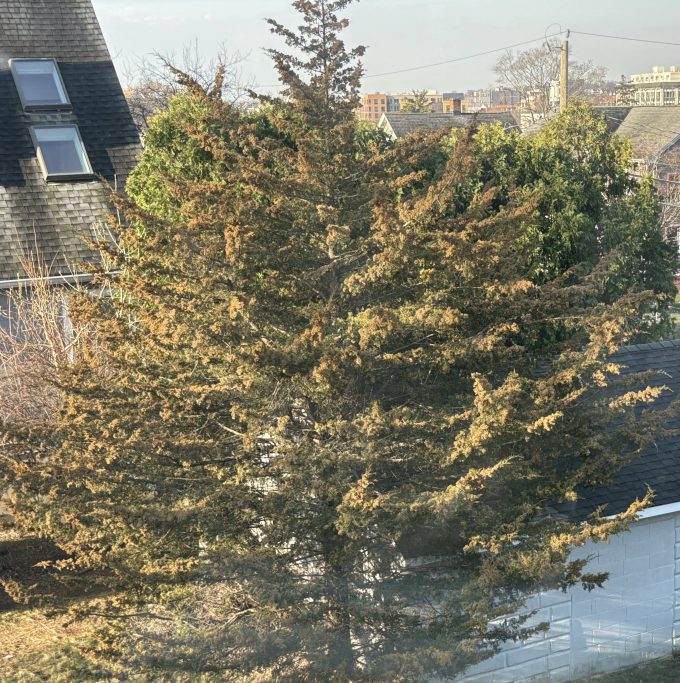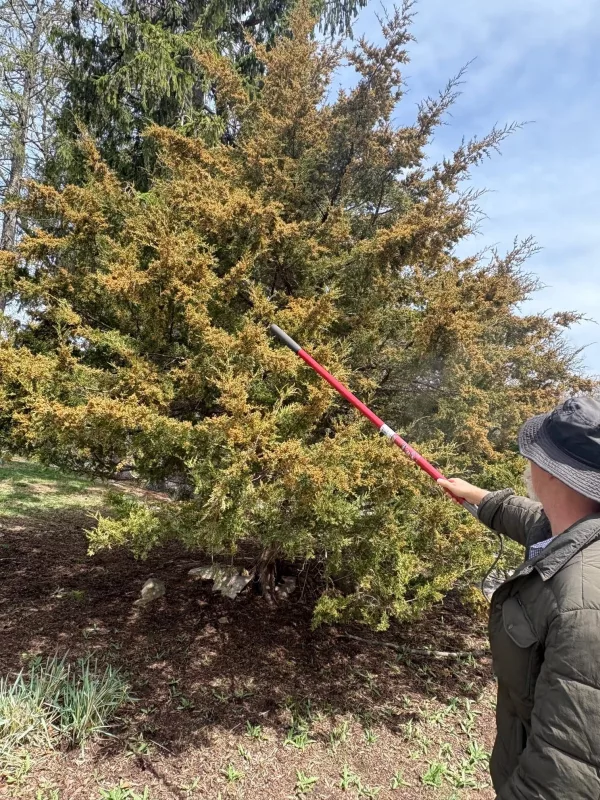On My Watch – Introducing via the Greenwich Fire Department, a Pollen Explosion

By Anne W. Semmes
On Saturday morning, nearly two weeks ago, a scene outside my Byram kitchen window was worrying. Wisps of smoke were seen drifting by coming from a next-door garage and adjacent evergreen tree. Those wisps were becoming billowing clouds of smoke. With some construction going on in the garage owner’s house the thought was maybe there was some activity inside the garage. But seeing no workers, and alarmed, I called the landlord. He said, “Call the fire department.”
Within minutes came the siren sound of fire engines bringing two fire trucks and a fire chief car, and suddenly a dozen or more firemen were rushing towards those billowing clouds of smoke. The firemen encircled the evergreen tree and garage, investigating all, then minutes later they were all focused on the evergreen tree. One of the firemen reached forward, grabbed a branch and shook it – and out came the smoke!
That fireman turned around with a smile on his face, and I heard him say “Its Pollen!” The firemen around him were all smiling. Flabbergasted I quickly made my way down to the firemen gathered before the tree they identified as a Red Cedar. “Do you have allergies to pollen?” I was greeted by a firefighter. “No,” I answered. Had they ever seen such an explosion of pollen blowing in the wind? The answer was a collective no. Then, off they went, those firemen and fire trucks departing as quickly as they arrived. Leaving me with many questions!
Days later I visited the Greenwich Fire Department, eager to learn more from those firemen who had come to the rescue. “We’d never heard of this before,” reported Assistant Chief Charlie Lubowicki, who’d led those firemen on that call. “We’re happy to respond, and to find it wasn’t an emergency.”
I also met up with three firemen, Spencer Padget, Brian Kelly, and Lt. John Nixon who wasn’t on the pollen explosion call. But he noted that 15 firemen had responded. “When we go to a call like that, we’re looking for signs of smoke or fire or other hazards…Obviously it was called in as possible smoke from a structure…We’re looking to see if the building is currently on fire, or at risk of catching on fire.”
“We saw what looked like smoke coming from the [garage] structure,” told fireman Padget. “We didn’t smell any odor of smoke or any burning.” But “It looked very like insipient smoke. We conducted a 360-degree around the structure. We felt the door for heat. There were no signs of heat.”
“At that point,” Padget continued, “we realized it was coming from the tree. So, we tapped the tree and saw all the pollen coming off it. It was a windy morning, so it was only that tree interacting or pollinating with the wind…It was definitely an interesting phenomenon.”
Time to address this phenomenon with Town Tree Warden Dr. Greg Kramer. Meeting up with him at the Pinetum, he said he had witnessed a pollen explosion last year at the Pinetum. “We were in front of the greenhouse and suddenly this wind came, a gust of wind, and suddenly, this huge amount of pollen was coming out of the tree. It was quite outstanding.”
Was he aware of how surprising this phenomenon is to the general public? “Not until very recently,” he said, “You brought it certainly to my attention…Some trees may not produce copious amounts of pollen every year.” But it’s that Eastern Red Cedar tree, as in my backyard, that can produce such pollen explosions “but it may not have done so for many years.”
It was then that Tree Warden Kramer gave me his pollen tutorial. Pollen explosions do not occur on cloudy, muggy days. “Usually, it’s a very sunny breezy day,” as it was on that Saturday of nearly two weeks ago.
“Nature’s amazing in the sense that the trees synchronize altogether of releasing the pollen in March and early April…The strategy is to throw as much pollen out there as you can, and hopefully that’ll catch a neighboring tree and then you can crosspollinate.”
“There’s two parts to the pollination process,” he continued. “So, it’s only the male part of the tree that’s giving out this pollen,” and yes, most conifers have both male and female parts. “So, at the time the pollen’s being released, the female part is receptive to the pollen, and thus, once it’s pollinated, the tree will produce the female cones [small bluish berry-shaped] with seeds for the next generation.” But he clarified, although both male and female parts are on the tree, “It’s not necessarily self-pollinating. The pollen’s going out to the neighboring tree.” And perhaps that neighboring tree may not be producing pollen, “but the female parts are receptive, so you get crosspollination.”
“Junipers [of which the Eastern Red Cedar is a species] are interesting,” he told. “They don’t produce cones like many conifers do – they produce these berry-like cones, and they leave it to the wind to disperse it to new locations.” And those seed-filled berry-like cones were a favorite he said of those properly named Cedar Waxwing birds.
Then it was time for the Tree Warden to demonstrate that pollen exploding from a Red Cedar tree at the Pinetum – as promised. With a borrowed red stick, he reached out across the length of the tree, touching branch after branch. But, alas, only the slightest whisper of pollen smoke appeared. How I wish I had thought to photograph that “pollen explosion” beneath my kitchen window! But I was simply too gobsmacked to grab my camera!






